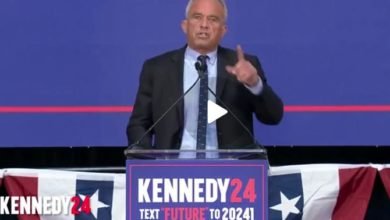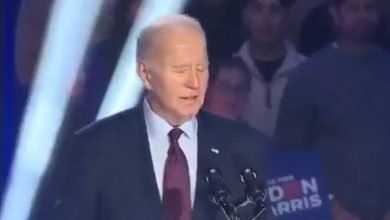Medal of Honor Monday: Navy Rear Adm. Daniel J. Callaghan
Navy Rear Adm. Daniel Judson Callaghan had been in the service for a long time before World War II sent him to the Pacific, where he commanded ships fighting against a massive enemy force during one of the deadliest battles of the war. Callaghan didn’t survive the ordeal, but his leadership, foresight and courage helped lead his sailors to victory. That earned him a posthumous Medal of Honor.
Callaghan was born July 26, 1890, in Oakland, California, to parents Charles and Rose Callaghan. He had two brothers and two sisters, and as a young man, he was an altar boy who enjoyed camping with his family in the Yosemite Valley. Callaghan went to Saint Ignatius, a Catholic preparatory school, before earning an appointment to the Naval Academy, from which he graduated in 1911.
From there, he began his long and fruitful service to the Navy, starting with a stint on the USS California, where he was part of the landing forces in Nicaragua under famed Marine Corps Maj. Gen. Smedley Butler.
In 1914, he married Mary Tormey. They eventually had a son, Daniel Jr.
During World War I, Callaghan was on the USS New Orleans serving as the ship’s engineering officer before being named its executive officer. By the end of the war, he’d earned the permanent rank of lieutenant commander.
During the 1920s, Callaghan spent time on several ships and served as an aid to two commanders before becoming a commander himself in 1931. By 1938, he’d worked his way up to being the naval aid to President Franklin D. Roosevelt, a position he held for three years.
By April 1942, when the U.S. was in the throes of World War II, Callaghan was promoted to rear admiral while commanding the cruiser USS San Francisco.
By November, parts of the South Pacific fleet, including the San Francisco, were in the middle of the bitterly fought Naval Battle of Guadalcanal. The Allies had retaken Guadalcanal in the Solomon Islands in August 1942, and the Japanese were desperately trying to take it back. Their leaders figured their best way to do so would be to suppress and destroy U.S. aircraft flying out of Henderson Field on Guadalcanal.
On Nov. 12, 1942, Callaghan was commanding Task Force 67.4, which consisted of three light cruisers, eight destroyers and two heavy cruisers, including the San Francisco, the task force’s flagship. Their main mission was to protect U.S. ships from submarine, air and surface attacks and to block Japanese ships from delivering troops to Guadalcanal’s shores.
However, on that night, Callaghan learned an impending Japanese naval bombardment was heading toward his task force’s position, which was in Iron Bottom Sound between Guadalcanal and Savo Island.
The Japanese ships were superior in numbers and in power. Callaghan’s forces struggled to deal with navigational communications problems, yet they still managed to surprise the enemy. Once fighting started, however, it was chaos, according to naval historians — a chaos that made an accurate chronology of the battle’s events hard to come by.
According to a 1942 article in the San Francisco Examiner, the USS San Francisco was the first to face enemy ships by taking on the Hiei, a Japanese battleship, in a head-on duel in the middle of the night. Callaghan and the San Francisco’s commanding officer during the engagement, Capt. Cassin Young, were both on the ship’s bridge wing directing close-range operations. The Hiei managed to fire off several shells, one of which killed Callaghan and Young.
The blast also knocked the ship’s communications officer, Lt. Cmdr. Bruce McCandless, unconscious. When he woke up, he realized Callaghan and Young were gone, so he took command of the ship as well as the task force, ordering many of the ships to continue their bombardment. According to a newspaper column written by journalist Drew Pearson, McCandless didn’t want to use the radio to tell the other ships in the task force that Callaghan had died for fear the messages would be intercepted by the Japanese. Because McCandless knew his superiors’ plan of attack, he went forward with it.
By the end of the night, the San Francisco managed to silence and disable the Hiei at a range of less than 3,000 yards, while also sinking a destroyer and damaging two other Japanese vessels.
Eventually, Japanese Rear Adm. Hiroaki Abe, who was commanding the enemy ships, lost his nerve and ordered his crews to withdraw and regroup, according to Navy historians.
According to naval intelligence reports, the battle sunk or destroyed 26 Japanese ships and damaged 12 more. Most importantly, it kept Japanese troops from being able to bombard Henderson Field. The naval battle was the last in a series that forced the Japanese to surrender Guadalcanal for good, handing the Allies a strategic victory.
The win came at a heavy price for the Allies, too. Nine U.S. ships were sunk while about a dozen more were damaged. More than 1,700 Americans lost their lives, according to the American Battle Monuments Commission. The Naval Battle of Guadalcanal was one of the deadliest of the war.
Having taken 45 direct hits, the San Francisco was heavily damaged but lived to fight another day. It became one of the most decorated warships of World War II.
Callaghan was buried at sea. He’s listed on the Wall of the Missing at the Manila Cemetery in the Philippines.
On Dec. 9, 1942, while visiting the White House, Callaghan’s son, Navy Lt. j.g. Daniel J. Callaghan Jr., received the Medal of Honor on his father’s behalf from President Franklin D. Roosevelt.
“Callaghan, with ingenious tactical skill and superb coordination of the units under his command, led his forces into battle against tremendous odds, thereby contributing decisively to the rout of a powerful invasion fleet, and to the consequent frustration of a formidable Japanese offensive,” his Medal of Honor citation read. His actions contributed to turning the tide against the Japanese in the Pacific.
“This is a very sad occasion for me, you know. Dan Callaghan was a very good friend of mine,” the president said during the ceremony.
Two others who were aboard the USS San Francisco during the battle — McCandless and Rear Admiral Norman Scott, who also died — received the Medal of Honor for their actions. McCandless went on to become a rear admiral himself, retiring from service in 1952.
Callaghan’s name continues to be of relevance across the Navy. Not one but two destroyers were named for him after his death. The first USS Callaghan was in use from 1943 until it was lost during battle in Okinawa in 1945. The second USS Callaghan was in use from 1981-1998.
Callaghan Hall at Officer Training Command in Newport, Rhode Island, and Callaghan Fitness Center at the Norfolk Naval Shipyard in Portsmouth, Virginia, are named in his honor. There’s also a monument to him in his native San Francisco, as well as an Admiral Callaghan Lane in Vallejo, California.
This article is part of a weekly series called “Medal of Honor Monday,” in which we highlight one of the more than 3,500 Medal of Honor recipients who have earned the U.S. military’s highest medal for valor.
Source: Department of Defense
Content created by Conservative Daily News is available for re-publication without charge under the Creative Commons license. Visit our syndication page for details.




